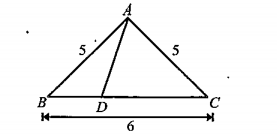ABCD is a square A≡(1,2),B≡(3,−4). If line CD passes through (3,8), then the midpoint of CD is (a) (2, 6) (b) (6,2) (c) (2,5) (d) (285,15)Solution in Bengali
(2,6)
(6,2)
(2,5)
(28/5,1/5)
The correct Answer is:D

mAB=−4−23−1=−3
Thus, the equation of CD is y-8
=-3(x-3), i.e., y+3x=17. The equation of the right bisector of AB is
y+1=13(x−2)
or 3y=x-5
Solving it with line CD, we get x=28/5, y=1/5. Thus, the midpoint of CD is (28/5,1/5).
Topper's Solved these Questions
- STRAIGHT LINESBOOK - CENGAGE PUBLICATIONCHAPTER - STRAIGHT LINESEXERCISE - EXERCISE (MULTIPLE CORRECT ANSWERS TYPE)
30 Videos
- STRAIGHT LINESBOOK - CENGAGE PUBLICATIONCHAPTER - STRAIGHT LINESEXERCISE - EXERCISE (LINKED COMPREHENSION TYPE)
27 Videos
- STRAIGHT LINESBOOK - CENGAGE PUBLICATIONCHAPTER - STRAIGHT LINESEXERCISE - CONCEPT APPLICATION EXERCISE 2.6
5 Videos
- STRAIGHT LINEBOOK - CENGAGE PUBLICATIONCHAPTER - STRAIGHT LINEEXERCISE - Multiple Correct Answers Type
8 Videos
- THEORY OF EQUATIONSBOOK - CENGAGE PUBLICATIONCHAPTER - THEORY OF EQUATIONSEXERCISE - JEE ADVANCED (Numerical Value Type )
1 Videos
Similar Questions
If P is a point (x,y) on the line y=−3x such that P and the point (3, 4) are on the opposite sides of the line 3x−4y=8, then x>815 (b) x>85 y<−85 (d) y<−815
View SolutionLet l be the line belonging to the family of straight lines (a+2b)x+(a−3b)y+a−8b=0,a,b∈R, which is farthest from the point (2,2), then area enclosed by the line L and the coordinate axes is
View SolutionIf aandb are two arbitrary constants, then prove that the straight line (a−2b)x+(a+3b)y+3a+4b=0 will pass through a fixed point. Find that point.
View SolutionThe point P(α,α+1) will lie inside the triangle whose vertices are A(0,3),B(−2,0) and C(6,1) if
View SolutionThe number of distinct real roots of x4−4x3+12x2+x−1=0is_____.
View SolutionABCD is a square A≡(1,2),B≡(3,−4). If line CD passes through (3,8), then the midpoint of CD is (a) (2,6) (b) (6,2) (c) (2,5) (d) (285,15)
View SolutionIf a+1=b+2=c+3=d+4=a+b+c+d+5, then (a+b+c+d) is equal to
View SolutionIf points A(5, p), B(1, 5), C(2, 1) and D(6, 2) form a square ABCD , then p= (a) 7 (b) 3 (c) 6 (d) 8
View SolutionFind the values of a,b,c and d, if 3[abcd]=[a6−12d]+[4a+bc+d3].
View SolutionFind the values of a,b,c and d, if 3[abcd]=[a6−12d]+[4a+bc+d3].
View SolutionABCD is a square A≡(1,2),B≡(3,−4). If line CD passes through (3,8), then the midpoint of CD is (a) (2, 6) (b) (6,2) (c) (2,5) (d) (285,15)
View SolutionIf points A(5, p), B(1, 5), C(2, 1) and D(6, 2) form a square ABCD , then p= (a) 7 (b) 3 (c) 6 (d) 8
View SolutionFind the values of a,b ,c and d, if
3[abcd]=[a6−12d]+[4a+bc+d3]
View SolutionFigure shows triangle ABC such that AB=AC=5,BC=6.P∮DisonB Csuchtˆ(B D)/(D C)=1/2,then□of≤n>hofsA D is

View SolutionABCD is a square A≡(1,2),B≡(3,−4). If line CD passes through (3,8), then the midpoint of CD is
View Solution
